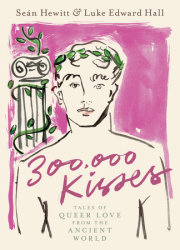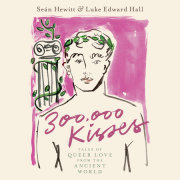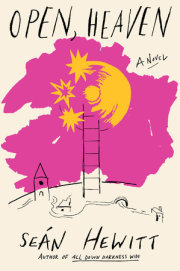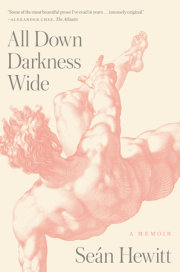PrologueIn the two brief lyrics by the Ancient Greek poet Theognis which open this book, we get a first glimpse into the sunlit classical Mediterranean. In one poem, the springtime, and the blooming of the flowers, becomes the blossoming of love and desire. It moves across the land, mysterious and sacred. In the other poem, a boy is like a horse, full of muscular heat, drawn with urgency back to his lover. These verses are frank and tender. They give us sight of a world long before our own, where queerness was not only acknowledged, but shown to be utterly part of the fabric of life. The erotic takes place alongside the elemental; nature governs the passions; everything is full of longing and it is only right that we are too.
It is natural, when we don’t see ourselves reflected in the world around us, to look for another world. It is natural, when we feel alone, to seek connection. All of us look for a past, but what happens when, gazing back in time, we see a world without us? That idea of a world without us is a lie, and the gaps in its history are no accident. But history is not the past, only the way it is written. Look closer, look longer, and what might first appear as a black sky suddenly seems to sparkle with a hundred constellations.
For queer people, the act of recovering history has often been one of discovering it, too. Is it any wonder that, placed on the dock during his trial for gross indecency, Oscar Wilde spoke of a love common to Plato, and Michelangelo, and Shakespeare? History and culture were proof of an enduring love that could produce some of the greatest works of art his audience knew. Picking up that golden thread, and placing himself as one of its inheritors, was an audacious and supremely affecting move. Many people in the court gallery, almost in spite of themselves, applauded.
Those names Wilde spoke of may be familiar to you, but I invite you to add the names of the characters and writers in this book, too. It is a long and glorious list. Every queer person has this same past, and deserves to inherit it. That sudden outbreak of applause in the courtroom is a glimpse of what it is like to witness a birthright brilliantly reclaimed. It takes our breath away, and its power resonates far and wide. It is that same radical and revelatory feeling I experience when I read these queer tales from the ancient world. I find that, rather than being cast out on the dark tide of history, I am sailing in a ship of gold.
When I first read that speech by Oscar Wilde as a teenager, I felt like the world, and my place within it, was forever changed. I found a hoard of jewels hidden from public view: a vibrant, justifying life beckoning me with what felt like a promise of belonging. When I heard whisperings about Ancient Greek culture at school, I felt like I was being told a secret. Those scraps of history felt illicit, mysterious, thrilling. I went off in pursuit of as much evidence as I could get my hands on, finding queer heroes and heroines and reading myself through them as I went. I came across Achilles first, a warrior whose name I knew because a part of my own body was named after him. Even a tendon in my own heel linked me into a queer story that no one had ever mentioned to me before. My heel was just like his, my body an heir to myth.
Through other traces, I picked up on this secret history. That golden thread is stitched throughout our culture’s ideas of queerness: think, for example, of the very terms ‘Sapphic’, ‘Lesbian’ and ‘androgynous’, all of which have classical roots and inferences. As you read these tales, you will find many ways in which queer love and desire are woven all the way through the ancient world. They are carved into stones, and take their places among the flowers and the animals; they are an equal and fundamental part of those epics which have shaped the history and imagination of entire cultures.
There are some very contemporary questions provoked by reading these classics. Who do we imagine love for? Who do we credit with desire? On whom do we bestow the gift of immortality? Can the body be changed to better suit the soul inside? By picking up these questions in our own time, and by tracing them back through the tales of the ancients, we see new pathways, new pasts, and new ways of moving forward. What we find is the illumination of a world that completely overthrows the puritanism of our own. The exuberant frankness of the Greeks and Romans makes a mockery of how narrow our popular vision is, even now.
But things are, as always, not so simple. Though the writings in this book showcase much discussion of beauty, camaraderie and desire, there is also material not so easily assimilated into modern progressive thinking. A variety of gender roles and gender identities emerge in both the Roman and the Greek worlds, but they are not universally celebrated. Reading these new versions of the classics, you might find yourself seeking to map our own language and understandings on to this past. It is hard to move the words we use for our identities back in time – each arises out of its own historical context. Still, while the ancients might not have had concepts like ours (gay, or bisexual, or queer, or trans), the essential humanity tempts us to draw links, and of course there are careful links to be drawn. There are divine transformations of boys into girls and vice versa, there is an attention given to the ‘androgyne’ or ‘hermaphrodite’ and a focus on the ways some sexual desires and identities are accepted, and others curtailed by the societies of the ancients.
Of course, any representation of sex and desire has to make room for fantasy, and for the power dynamics of the gaze, and it is difficult to know what women, gender non-conforming people and persons of the lower classes would have made of these tales. In Martial’s
Epigrams, for instance, we meet two impressive butch women, Philaenis and Bassa. The gaze of the writer is both enthralled by their power and also keen to censure their rejection of men. He is both aroused and irritated. As modern readers, we catch a peek into this queer world, all the while being made aware of the misogyny that frames it. We also recognize a similar tendency in the modern male gaze: the objectification of women coupled with a terror of their sexuality.
The relationships between queer women are much less well documented in the literature of the Greek and Latin classics. Even in this book, where we bring you new versions of texts about what we might now call gender non-conforming characters and queer women, the insights are often fragmentary. Sappho’s pulsing fragments are hymns to women beloveds, and a rare graffiti poem from Pompeii attests to the ways in which female desire and relationships were passed through song and stone. A love spell found on papyrus from Egypt shows the incantatory depths of female desire, full of energy and passion; and the tale of Iphis and Ianthe, from Ovid’s
Metamorphoses, plays with gender roles and the love between women.
The complex perspectives and receptions of these texts (these are tales told through the lens of satire, debate, and across a gulf of both real and imagined time) leave room to debate what is being endorsed, and what is being sanctioned. The ancient world is not a perfect mirror, nor is it one that offers uncomplicated images. Class, gender and sexual proclivity were then, as they still are, recognized as barriers to full freedom and acceptance. It is important to be aware of the imperfections and the alterity of these idealized societies, as well as to revel in their passionate music.
In these pages, you will likely find yourself moved, celebrated and troubled in equal measure. There are moments of tantalizing closeness between the reader and these passages, and moments of shocking distance. Importantly, we have not censored these texts. Though many have a history of being erased from modern editions (as with some of Martial’s ‘obscene’ epigrams on homoerotic desire between women), we present them here in all their messy glory.
It struck me, as I was reading these texts, how often the stories, which regularly end in tragedy, subsume the beloved into the world of the gods, or hold the shape of their bodies in flowers that return each year, or in constellations that outlast any mortal. Their queerness, and their endurance, is wrapped up in myth-making, in origin stories, so that the world around us might be seen as the product of desire, yearning, and the deep grief of separated lovers. The characters are moved by the gods, by their passions, and by nature’s changing seasons. Women turn into flowers, and etch their longing into stone; men inscribe their tears into petals, frequent steamy bathhouses and carve dildos from the branches of trees growing from the tombs of their old lovers. The gods, painfully in love with mortals, grieve and turn them into constellations. In this way, queer love is written through the landscape and through the heavens, deeply connected to the world it exists in, running a bright thread of longing across the intervening years. When we consider the many and ongoing erasures of queer history, the baffling silences of the archives, it is deeply moving to see a world, far off from our own, with queerness flowing through its very fabric.
Copyright © 2023 by Seán Hewitt and Luke Edward Hall. All rights reserved. No part of this excerpt may be reproduced or reprinted without permission in writing from the publisher.













